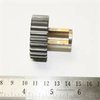On the VOC Spares site, the photo of the D spindle part number ET159/1 (or the later parts book MO13) shows the flat. I have an NOS one here in the photo, but didn't want to use it due to some pitting from corrosion, although the pits might help hold oil.
Based on your responses (thank you) I decided to go dig out the idler that mounts on it and there are two oil holes in the bush that line up with the flat, so now it becomes obvious that they put the flat there to hold whatever oil mist should find its way in. I recall looking at this pinion previously and wondering if it was OEM or something that was just made up by someone.... but now looking at a later (D era) MO13, it shows the oil hole in the bushing. As for indexing, I'm assuming the flat should be towards the top in order to hold more oil while hopefully keep it away from the cam and mag pinions because of the aforementioned reduced bearing area. If anyone can confirm my assumption on the indexing, it would be appreciated.


Based on your responses (thank you) I decided to go dig out the idler that mounts on it and there are two oil holes in the bush that line up with the flat, so now it becomes obvious that they put the flat there to hold whatever oil mist should find its way in. I recall looking at this pinion previously and wondering if it was OEM or something that was just made up by someone.... but now looking at a later (D era) MO13, it shows the oil hole in the bushing. As for indexing, I'm assuming the flat should be towards the top in order to hold more oil while hopefully keep it away from the cam and mag pinions because of the aforementioned reduced bearing area. If anyone can confirm my assumption on the indexing, it would be appreciated.

